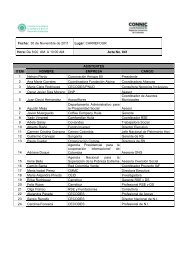Setting new standards - Friends Life
Setting new standards - Friends Life
Setting new standards - Friends Life
You also want an ePaper? Increase the reach of your titles
YUMPU automatically turns print PDFs into web optimized ePapers that Google loves.
PARENT COMPANY ACCOUNTS<br />
ABBREVIATIONS AND DEFINITIONS<br />
Notes to the consolidated accounts continued<br />
30. Risk management objectives and policies for mitigating risks continued<br />
For over-the-counter derivative transactions undertaken by the Group, collateral is received from the counterparty if the contract is in-themoney<br />
(ie is an asset of the Group’s and over any agreed minimum threshold). This collateral can be sold or repledged by the Group and is<br />
repayable if the contract terminates or the contract’s fair value falls. At 31 December 2006 the fair value of such collateral held was £181m<br />
(2005: £241m). No collateral received from the counterparty has been sold or repledged.<br />
In respect of deposits with credit institutions and cash and cash equivalents, Group policy is to hold cash and deposits in AAA money funds<br />
or financial institutions with a rating of above AA.<br />
(d) Liquidity risk<br />
The Group faces two key types of liquidity risk: shareholder liquidity risk (liquidity within funds managed for the benefit of shareholders, including<br />
shareholders’ interests in long-term funds) and policyholder liquidity risk (liquidity within funds managed for the benefit of policyholders).<br />
Longer-term shareholder liquidity risk will be taken on when it is deemed financially beneficial for the organisation to do so, or where the<br />
taking of this liquidity risk is in support of strategic objectives. Short-term shareholder liquidity risk is avoided due to the need to satisfy<br />
dividend expectations whilst having a limited timeframe to raise capital. Policyholder liquidity risk is not accepted, over either a short or<br />
longer-term timeframe, in all but the most extreme scenarios. The same is true for liquidity risk in F&C’s investors’ funds.<br />
The overall objective of shareholder liquidity risk management is to ensure that there is sufficient liquidity over short (up to one year) and<br />
medium time horizons to meet the needs of the business. This includes liquidity to cover, amongst other things, <strong>new</strong> business costs, planned<br />
strategic activities such as acquisitions, servicing debt and equity capital as well as working capital to fund day-to-day cash flow requirements.<br />
For policyholder funds, liquidity risk arises from a number of potential areas, including:<br />
• a short-term mismatch between assets and liabilities<br />
• having to realise assets to meet liabilities when asset values are depressed<br />
• an unexpectedly high level of lapses/surrenders.<br />
Liquidity risk is managed in the following way:<br />
• Forecasts are prepared regularly to predict required liquidity levels over both the short and medium term.<br />
• Committed third-party funding facilities are held to enable cash to be raised in a relatively short time-span.<br />
• Credit risk of cash deposits is managed by applying counterparty limits and imposing restrictions over the credit ratings of third parties with<br />
whom cash is deposited.<br />
• Assets of a suitable maturity and marketability are held to meet policyholder liabilities as they fall due.<br />
• Limits are set on the level of lower grade or speculative investments that can be held.<br />
The Group has issued fixed rate subordinated loan notes repayable in 2016, with the option of extending the term to 2026 (at a floating rate).<br />
This has provided the Group with long-term flexible funding at a fixed rate of interest.<br />
<strong>Friends</strong> Provident Annual Report & Accounts 2006 151

















